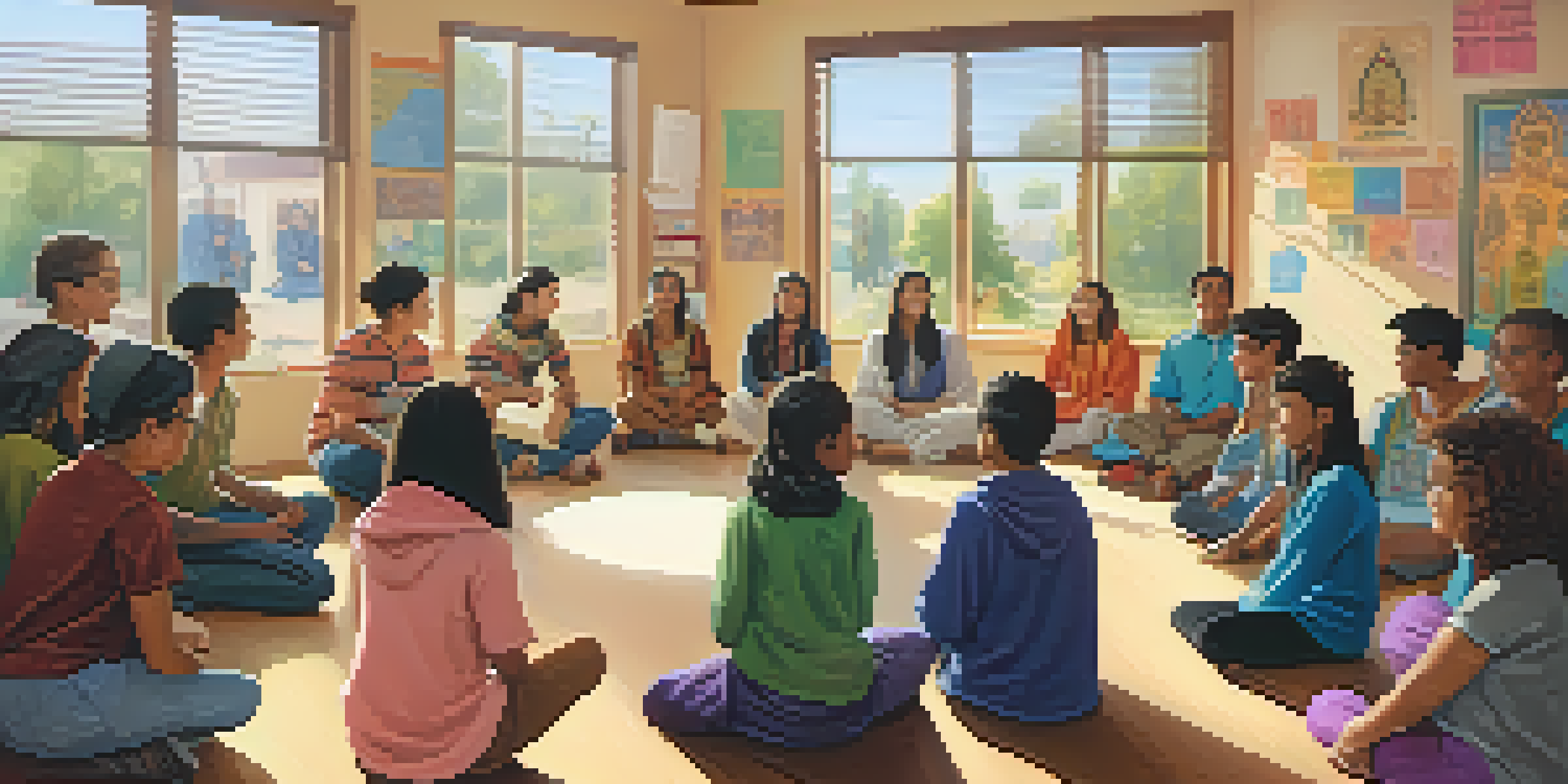Interfaith Dialogue in Education: Bridging Cultural Divides

Understanding Interfaith Dialogue in Educational Settings
Interfaith dialogue involves open conversations between individuals of different faiths, aimed at fostering respect and understanding. In educational settings, this practice can be incredibly valuable, as students learn about diverse cultures and beliefs. By encouraging dialogue, schools create an inclusive environment where students feel safe to express their identities and perspectives.
Dialogue is the most effective way of resolving conflict and building understanding.
Imagine a classroom where students from various backgrounds come together to share their traditions and stories. This not only enriches the learning experience but also helps dispel myths and stereotypes. When students engage in discussions about their beliefs, they develop empathy and a broader worldview.
Such an approach doesn’t just benefit students; it also equips future leaders with the skills needed to navigate a multicultural world. As our society becomes more diverse, the ability to engage in constructive dialogue is crucial for social cohesion and harmony.
The Role of Educators in Facilitating Dialogue
Educators play a pivotal role in interfaith dialogue by creating a safe space for discussions. They can introduce topics related to various religions and cultures, guiding students in respectful conversations. By modeling open-mindedness, teachers encourage students to explore their beliefs while remaining receptive to others.

For instance, a history lesson on world religions can be transformed into an interactive session where students share their own experiences. This approach not only makes learning more engaging but also fosters a sense of belonging among students. When educators facilitate meaningful discussions, they help students develop critical thinking and communication skills.
Interfaith Dialogue Enhances Learning
Engaging students in conversations about diverse beliefs fosters empathy and enriches their educational experience.
Moreover, professional development for teachers can enhance their ability to handle sensitive topics related to faith. By equipping educators with the right tools and knowledge, schools can ensure that interfaith dialogue becomes an integral part of the curriculum.
Creating Inclusive Curriculum Through Interfaith Perspectives
An inclusive curriculum that incorporates interfaith perspectives can significantly enrich students' learning experiences. By including texts, histories, and examples from various faith traditions, educators can provide a more holistic view of the world. This not only validates students' identities but also piques their interest in learning about others.
We must learn to live together as brothers or perish together as fools.
For example, a literature class could include stories from different religious backgrounds, allowing students to explore common themes like love, sacrifice, and justice. This approach highlights the universal values shared across religions, inspiring discussions that promote understanding. When students recognize these parallels, they are more likely to appreciate the diversity around them.
Additionally, integrating interfaith perspectives can help debunk misconceptions and foster a sense of community within the classroom. By acknowledging and celebrating differences, educators create a vibrant learning environment where students can thrive.
The Impact of Interfaith Dialogue on Student Relationships
Interfaith dialogue can significantly improve relationships among students from different backgrounds. When students engage in open conversations about their beliefs, they often find common ground, fostering friendships across cultural divides. These connections can help reduce bullying and discrimination, creating a more harmonious school atmosphere.
Consider a school that organizes interfaith events, such as cultural fairs or panel discussions. These activities encourage students to interact and collaborate, breaking down barriers and creating bonds based on mutual respect. As students learn about each other's traditions, they develop a sense of curiosity and appreciation for diversity.
Educators Foster Inclusive Discussions
Teachers play a crucial role in creating a safe space for interfaith dialogue, guiding respectful conversations among students.
Moreover, positive relationships formed through interfaith dialogue can extend beyond the classroom, influencing students' interactions in their communities. When young people are equipped with the skills to engage with others respectfully, they contribute to a more inclusive society.
Challenges of Implementing Interfaith Dialogue in Schools
While the benefits of interfaith dialogue are clear, implementing it in schools is not without challenges. Some educators may feel uncomfortable discussing religious beliefs due to personal biases or lack of knowledge. This discomfort can hinder open discussions and limit students' exposure to diverse perspectives.
Additionally, external factors such as community attitudes and policies can impact a school's ability to promote interfaith dialogue. In some areas, there may be resistance to discussing certain religions or beliefs, which can create tension among staff and students alike. Navigating these challenges requires sensitivity and a commitment to fostering an inclusive environment.
To overcome these obstacles, schools can provide training and resources for educators to build their confidence in leading interfaith discussions. By creating a culture of support and understanding, schools can embrace the complexities of interfaith dialogue and its vital role in education.
The Role of Community and Parents in Supporting Dialogue
The involvement of parents and the community is crucial in supporting interfaith dialogue in schools. When families engage in discussions about faith and culture, students receive reinforcement at home, which enhances their classroom experiences. Encouraging parents to participate in school events fosters a sense of community and shared responsibility for students' education.
For example, schools can host workshops or informational sessions that educate parents about the importance of interfaith dialogue. These events provide a platform for parents to share their experiences and learn from one another. When families understand and support the school's efforts, it creates a more cohesive environment for students to thrive.
Community Support Strengthens Dialogue
Involving parents and local organizations enhances interfaith initiatives, creating a more cohesive and inclusive school environment.
Furthermore, community partnerships can enrich interfaith dialogue initiatives. Collaborating with local religious organizations or cultural groups can provide valuable resources and diverse perspectives, making the learning experience even more impactful.
Measuring the Success of Interfaith Dialogue Initiatives
To ensure that interfaith dialogue initiatives are effective, it's important to establish clear metrics for success. Schools can assess the impact of these programs through surveys, interviews, and feedback sessions with students, educators, and parents. By gathering data, schools can identify strengths and areas for improvement.
For instance, measuring changes in students' attitudes towards diversity before and after participating in interfaith dialogue can provide valuable insights. Schools can also track the frequency of incidents related to bullying or discrimination, as a decrease in such incidents may indicate a positive shift in school culture.

Ultimately, measuring success is about understanding the broader impact of interfaith dialogue on students' lives. By continuously evaluating these initiatives, schools can adapt and enhance their programs, ensuring that they meet the evolving needs of their diverse student populations.